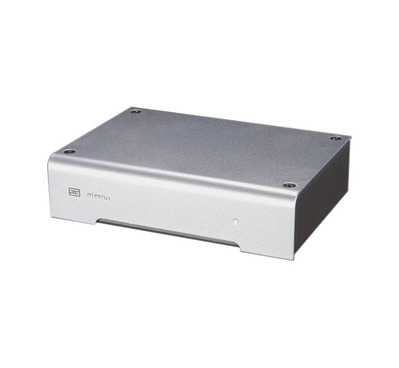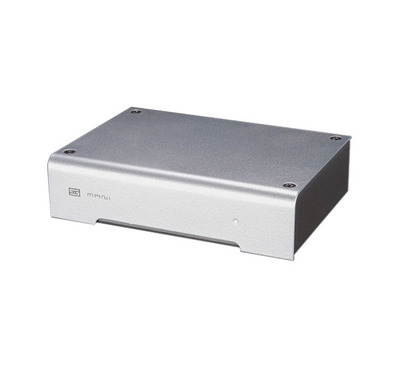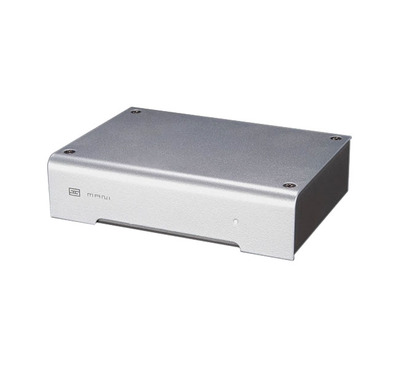Posted in
General
by
The Mani is a tiny metal box that's apparently made in the USA and only sold direct through Schiit. It has 2 loading options and three gain options that should handle most MM/MC cartridges.
The loading and gain settings are switchable underneath the chassis. Loading and Gain options are pretty limited but still better than many entry level phono stages under $500. Loading is 47/47K only while maximum gain is only 59db so for very low output MC cartridges, this might not be the best option.
Connections are RCA only, plus power input and a grounding post.
Fit and finish are generally OK, but it's definitely not going to win any beauty contests. The front of the box is a simple affair that is dominated by a blindingly bright power light while the rear provides the usual phono amplifier connections and a toggle power switch plus grounding point and access socket for the wall wart power supply.
The dynamics and transients are great, the bass is very articulated and controlled and there is no perceptible graininess or obvious rolloff. I've used other sub-$500 dedicated phono stages as well as internal preamps and everything that I hear through the Mani is better to my ears. Much more enjoyable to listen to.
Fuller sound, better dynamic range, more natural vocals and instruments, etc. I have several recordings that have been with me for years and with the Mani I was picking up on details that had previously been shrouded. In the best analog masters I did several A/B comparisons to lossless versions of the same recordings digitally and generally preferred the Mani in most cases, although it was often hard to tell the difference.
Overall, the Schiit Mani is at its price point one of the best phono stage you can get. Capable of punching way above its weight class.
The loading and gain settings are switchable underneath the chassis. Loading and Gain options are pretty limited but still better than many entry level phono stages under $500. Loading is 47/47K only while maximum gain is only 59db so for very low output MC cartridges, this might not be the best option.
Connections are RCA only, plus power input and a grounding post.
Fit and finish are generally OK, but it's definitely not going to win any beauty contests. The front of the box is a simple affair that is dominated by a blindingly bright power light while the rear provides the usual phono amplifier connections and a toggle power switch plus grounding point and access socket for the wall wart power supply.
The dynamics and transients are great, the bass is very articulated and controlled and there is no perceptible graininess or obvious rolloff. I've used other sub-$500 dedicated phono stages as well as internal preamps and everything that I hear through the Mani is better to my ears. Much more enjoyable to listen to.
Fuller sound, better dynamic range, more natural vocals and instruments, etc. I have several recordings that have been with me for years and with the Mani I was picking up on details that had previously been shrouded. In the best analog masters I did several A/B comparisons to lossless versions of the same recordings digitally and generally preferred the Mani in most cases, although it was often hard to tell the difference.
Overall, the Schiit Mani is at its price point one of the best phono stage you can get. Capable of punching way above its weight class.
Posted in
General
by
Posted in
General
by
Unlikely as it may seem, the vinyl revival is a real thing; vinyl has become the physical format of choice for many listeners young or old.
Putting together a turntable setup that will give you a great listening experience without breaking the bank is challenging. Hopefully this guide will help you when you want to try your hands on vinyl on a budget. This guide is based strictly on new components, you can buy them used to stretch your dollar. Just make sure they are in good condition so you can enjoy them for the time being before your next upgrade.
The Budget. I can’t say this enough, but if you really want to go into vinyl then you really need at least a sensible budget. It’s really no point to spend a few hundred dollars on a vinyl setup, you’re not going to get any of the benefits and you will give up after a few months and proclaim that vinyl is overhyped.
The Turntable.
U-Turn Orbit Basic (USD $179). The Orbit Basic delivers brilliant sound that fits into any music lover’s budget. It comes pre-fitted with a capable CN5625AL cartridge and low-resonance MDF platter. The Basic is easy to set up, use, and upgrade – making it a great place to start your vinyl journey.
Pro-Ject Essential III (USD $299). The Essential 3 is a pared-down version of the bestselling Debut Carbon DC. Featuring a much lower-price point, the Essential 3 is an excellent starter audiophile deck that provides a solid listening experience and sleek, minimalist design.
The Phono Stage.
A turntable produces a phono output signal. This phono signal needs to be converted to a line level signal/AUX signal to work with your amplifier or powered speakers. A phono stage converts Phono to Line Level. You can of course get an integrated amplifier with a built-in phono stage, but if you want to get the best out of your turntable, a standalone phono stage is the way to go.
Schiit Mani (USD $129). The Mani has 4 switchable gain modes, (30, 42, 47, and 59dB) is ready for any cartridge you can throw at it. Mani’s RIAA network is implemented fully passively. What that means is there are no poles in the feedback loop, for more consistent sonic performance. Coupled with precision 2% film capacitors, 0.5% thin-film resistors, and super low-noise gain stages, Mani delivers superb accuracy and performance, even well beyond its modest price.
The Amplifier.
The job of an amplifier is simply to produce a more powerful version of the audio signal. In our case, it will take the Line Level output from the phono stage and amplify the signal to your speakers.
Emotiva BasX A-100 (USD $229). The BasX A-100 is a great sounding, compact, and very flexible, stereo amplifier. It is an excellent choice for a wide variety of situations; from driving a small music system in a home or business, to providing audio for a second zone in a larger home theater installation, or whole house music system.
The Speakers.
Get floorstanding speakers if you have the space for it. If not bookshelf speakers are fine, though some might lack the bass compared to floorstanding speakers. You can also do without an amplifier if you get a pair of active speakers.
Klipsch R-14M (USD $149). The R-14M is a remarkable pair of copper and black bookshelf speakers that are guaranteed to put a smile on your face every time you fire them up. The small, versatile speakers are built to minimizes cone breakup and distortion, creating remarkable low frequency response and produce speaker efficiency and clean sound unrivaled in its price range.
Q Acoustic 2050i (UK £269.99). Visually striking in the Gloss Black or Gloss White finishes, the exquisitely proportioned 2050i is the front-runner of the 2000i Series. The 2050i boasts ultra-low levels of distortion, typically found of speakers costing three or four times as much. Not surprisingly, as a result it delivers a sound quality unrivalled at its price.
Edifier R1280T (USD $99.99). The R1280T powered bookshelf speakers has combined a retro look with a modern sense of audio quality. If you’re looking for affordable and versatile bookshelf speakers with uncompromising sound the R1280T bookshelf speakers is your go-to 2.0 speaker system.
Among the 4 components for a vinyl setup, the speakers are the one i would recommended to buy used. Get the best one you can afford. Your upgrade journey should be as follows –
Speakers > Amplifier > Turntable
I have left out the phono stage because the Schiit Mani is going to serve you for a long time((it is that good). Always upgrade your speakers and amplifiers first, how else can you hear the difference then? Happy Spinning!
Comments



